Accuracy of ultrasound elastography for predicting breast cancer response to neoadjuvant chemotherapy:A systematic review and meta-analysis
lNTRODUCTlON
Neoadjuvant chemotherapy (NACT) has been established as the standard mode of treatment for inflammatory or locally advanced breast cancer. Pathologic complete response (pCR) has been utilized as a surrogate marker for detecting the prognosis or long-term survival following NACT in breast cancer patients[1], with several studies showing a response rate of almost 70% and pCR rate of about 30%[1,2].Some factors were found to be associated with an increased risk of developing resistance to chemotherapy[3]. Hence, early prediction of the response to NACT in patients with breast cancer is critical.
Ultrasonic elastography (UE) is one of the most commonly used non-invasive imaging methods based on the mechanical properties of the tissue to assess the differences in breast lesion stiffness and elasticity(both quantitatively and qualitatively)[4]. It detects and quantifies the differences in tissue stiffness.Therefore, it can be used as an excellent imaging technique to differentiate benign and malignant breast masses[4]. There are two types of UE employed currently for examining the breast lesions,, shearwave elastography and strain elastography. Both techniques characterize the breast lesions based on the level of stiffness. Mean stiffness can be used as an effective preoperative predictor of progression of the disease in invasive breast cancer, and maximal stiffness has been used as a predictor of histopathological severity of breast lesions[4].
Breast cancer treatment with NACT might increase the probability of down-staging of the tumors.However, pCR to NACT is highly variable, and the current protocols to predict pCR to NACT are not sensitive enough. Formulating a tailored strategy using validated biomarkers to predict the degree of response to NACT has become a priority nowadays in the research of breast cancer. Several studies have reported the prognostic value of UE in patients receiving NACT for breast cancer. Breast masses with higher aggressive pathological properties can have higher stiffness value, suggesting that UE might provide very useful information to determine the prognosis of the patient[5]. However, the assessment of parameters is different for shear-wave elastography and strain elastography in terms of measured elasticity parameter and mode of imaging. To the best of our knowledge, no meta-analysis has yet assessed the accuracy of the two modes of elastography in predicting the response to NACT in breast cancer patients. The aim of the current study was to systematically search the literature for all studies assessing the accuracy of UE for predicting response to NACT in breast cancer, and pool the data for meta-analysis.
MATERlALS AND METHODS
Inclusion and exclusion criteria
The inclusion criteria were as follows:Studies evaluating the predictive accuracy of UE for pCR following NACT in breast cancer patients; studies using histopathological examination as the reference standards for finding the pCR for inclusion in our review; prospective and retrospective studies.
The exclusion criteria were as follows:Studies not reporting the values necessary for pooling the sensitivity and specificity; unpublished studies.
Search strategy
We had a comprehensive search strategy to screen the databases such as MEDLINE, EMBASE, SCOPUS,PubMed Central, CINAHL, Web of Science, and Cochrane library. We did not have any language restriction and time limit for the search was between the inception of database till December 2020. The following search terms were used:“Ultrasound Elastography”, “Neoadjuvant Chemotherapy”, “Breast Cancer”, “Breast Carcinoma”, “Validation Studies”, “Diagnostic Accuracy Studies”, “Pathologic Complete Response”, and “Remission”. We also hand-searched the bibliographies of the included studies and checked for any missed-out studies matching our eligibility criteria. The details for different search strategies employed for different databases are provided in the Supplementary Material.
Study selection process
Two investigators (LF and HC) were responsible for performing the primary search of the articles by screening the title and abstract, and downloading the relevant full-text publications. The same set of investigators also independently read the retrieved full-texts and checked whether the studies were meeting the eligibility criteria of our review. Disagreements were resolved with assistance from a third author (WC), which helped in reaching a consensus for study selection. We achieved an overall agreement of 97% with a kappa statistic of 0.87.
Not long after, I took my four-year-old son to an elegant department store, where the melodic3 notes of a classic love song drew us toward a tuxedoed4 musician playing a grand piano
Data extraction
The responsibility of data extraction from the final included full-text articles was assigned to the primary investigator. Data was extracted using a structured pre-defined form and directly transferred to the STATA software (StataCorp, CollegeStation, TX, United States). This data extraction form consists of the following components:Author and year of publication, country, design, participants, total sample size, study setting, details of UE, reference test, average age, cut-off (mean stiffness/strain ratio),sensitivity, and specificity. The third investigator ensured the data quality by double-checking data entries before performing the meta-analysis.
“Cleanliness is a good thing,” said she, scouring90 the vessel with snakes, which she had tied together in a large knot; then she pricked91 herself in the breast, and let the black blood drop into it
Risk of bias assessment
By now, Mrs. Thompson realized the problem and she was ashamed of herself. She felt even worse when her students brought her Christmas presents, wrapped in beautiful paper and tied with pretty ribbons, except for Teddy s. His present was clumsily() wrapped in the heavy, brown paper that he got from a grocery bag.
Statistical analysis
Since there are two techniques of UE (shear and strain wave elastography), we determined the better technique by performing a separate subgroup analysis and calculating pooled sensitivity and specificity for each of them. We found strain wave elastography as the better technique with a pooled sensitivity of 93% and specificity of 87% compared to shear wave elastography (77% and 84%). This means that strain elastography can help in effectively ruling out the pCR patients correctly as it had a sensitivity more than 90%. Strain elastography, therefore, has a major advantage over shear wave elastography, as studies report its good predictive performance for ruling out the patients with pCR.
Evaluation of heterogeneity was done by chi-square andstatistic. It is represented graphically by a bivariate box plot. Additional meta-regression analysis was performed to identify the source of the high heterogeneity found in our results. The covariates used in the meta-regression were study design,sample size, mean age, shear or strain wave UE, country, cut-off, and quality related factors. Deeks’ test was performed to assess the possibility of publication bias and it is graphically represented by funnel plot.
RESULTS
Study selection
We found a total of 754 records, amongst which 36 were found to be relevant for the full-text retrieval.Full-texts of two additional articles were retrieved after going through the bibliography of the selected articles. Finally, 14 studies with 989 participants have met the eligibility criteria and were included in our review (Figure 1)[7-20].
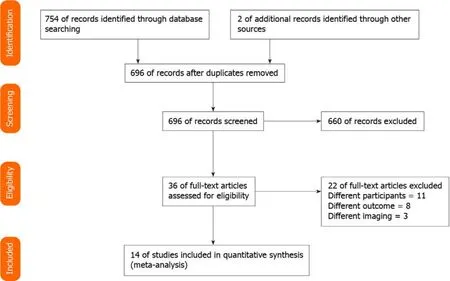
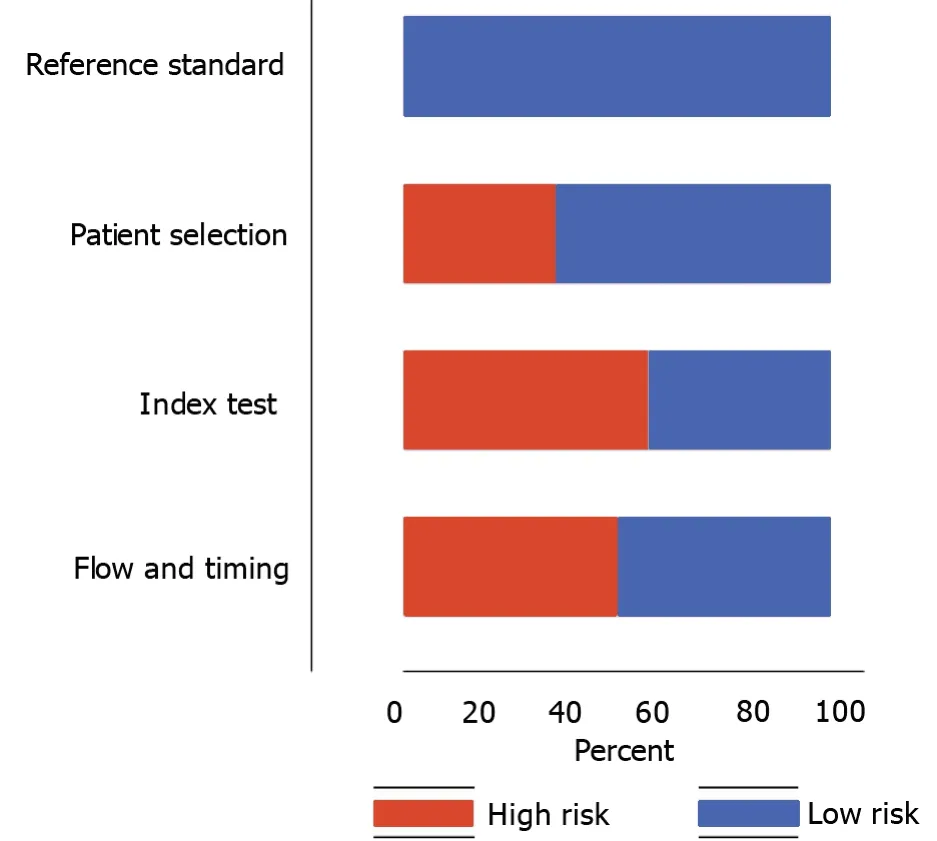
Characteristics of the studies included
Of 14 studies included in the analysis, 12 were prospective in nature. Six studies were conducted in China. The average age of the patients was 39 to 55 years. We analyzed data from 989 patients to assess the predictive accuracy of UE for pCR after receiving NACT (samples size of individual studies ranged from 15 to 134 patients). In total, seven studies assessed the accuracy of only shear wave elastography,six assessed the accuracy of only strain wave elastography, while only one assessed the accuracy of both shear wave and strain wave elastography. All the studies performed histopathological examination following surgical resection as the reference standard (Table 1).
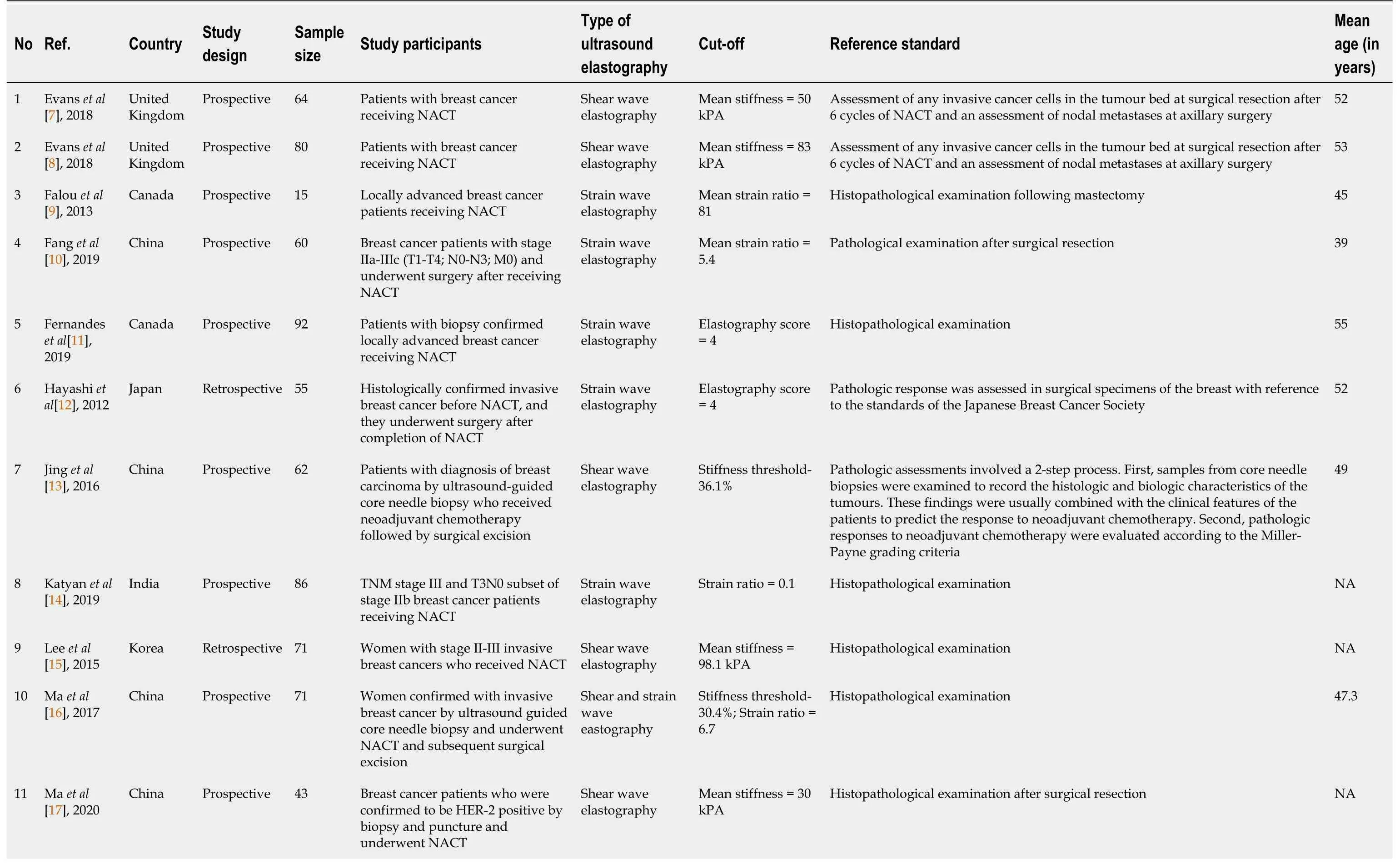

Risk of bias assessment
Risk of bias according to the QUADAS tool is shown in Figure 2. Five out of fourteen studies had a high risk with respect to patient selection domain, eight had a high risk of conduct and interpretation of index test bias, and seven had a high risk of patient flow and interval between index tests and reference standards bias. None of the studies had a high risk of bias with respect to the conduct and interpretation of reference standard.
Predictive accuracy of UE for pCR following NACT
As shown in Figures 3 and 4, the pooled sensitivity and specificity of UE for pCR amongst patients with breast cancer following NACT were 86% [95% confidence interval (CI):76%-92%] and 86% (95%CI:80%-90%), respectively. The DOR was 37 (95%CI:17-77). The LRP was 6 (95%CI:4-9) and the LRN 0.16 (0.09-0.30). The LRP and LRN in the right lower quadrant of the LR scattergram (Figure 5) indicate that UE cannot be used for confirmation or exclusion of pCR following NACT. As shown in Fagan’s nomogram(Figure 6), UE had a good clinical utility for predicting pCR following NACT (positive = 74%; negative =7%), as it differs significantly from the pre-test probability (32%). Significant heterogeneity was found with a chi-square< 0.001 and> 75%. Bivariate box plot further confirmed the presence of heterogeneity (Figure 7).
Deek’s test for publication bias indicated the absence of publication bias (= 0.59). This was further confirmed by the symmetrically shaped funnel plot (Figure 8). Meta-regression analysis was performed to assess the source of heterogeneity using the covariates. As shown in Figure 9, in the sensitivity model,patient selection (< 0.05) (< 0.05) could be a source of heterogeneity. Patient selection (< 0.05) as well as flow and timing of tests (< 0.001) were potential sources of heterogeneity in the specificity model, and the mean age was responsible for heterogeneity in the joint model (< 0.001).
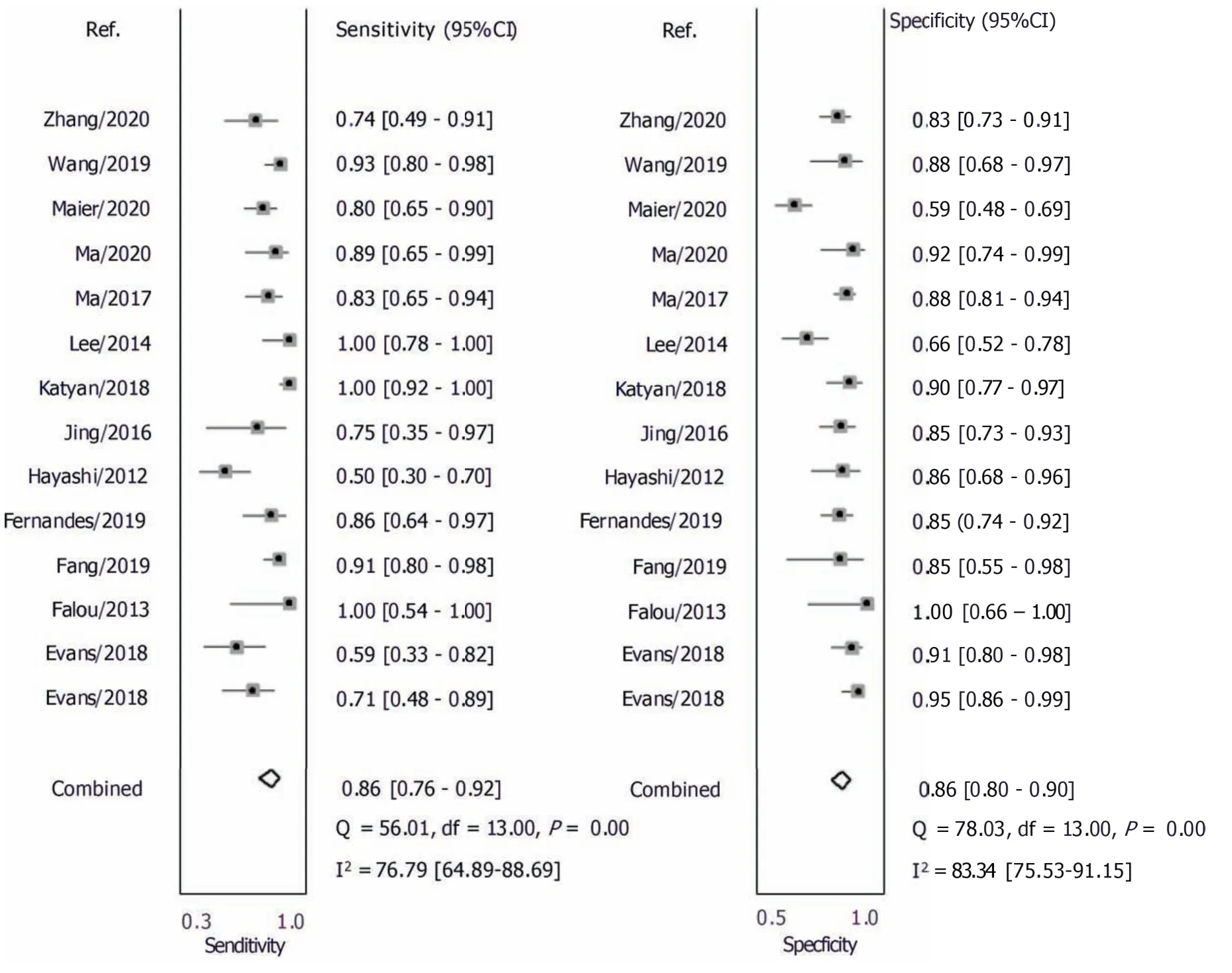

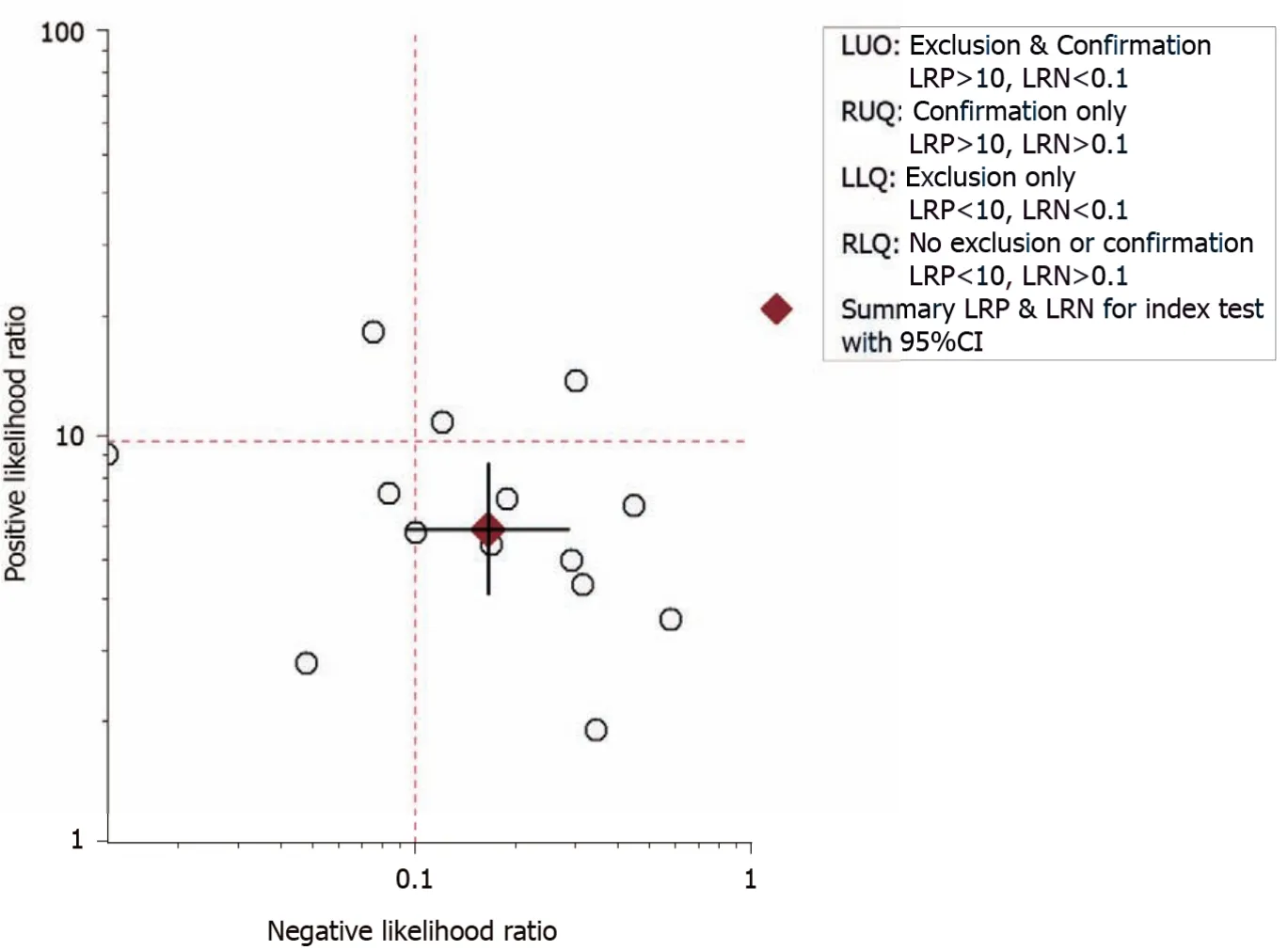
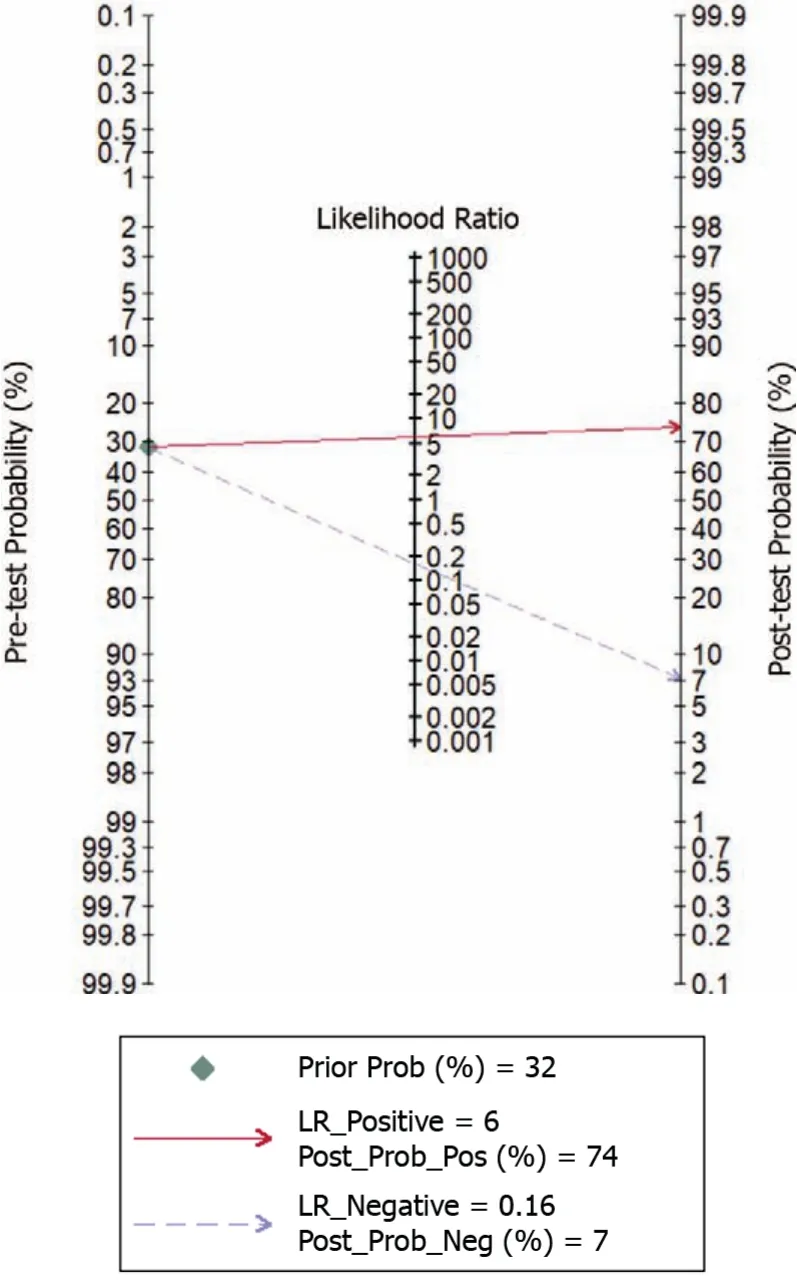
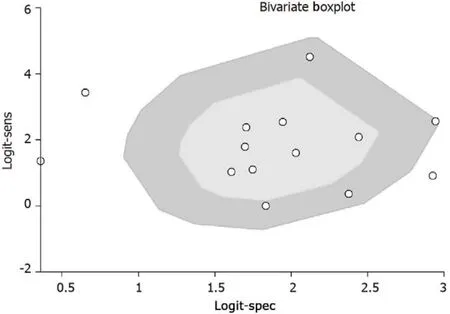
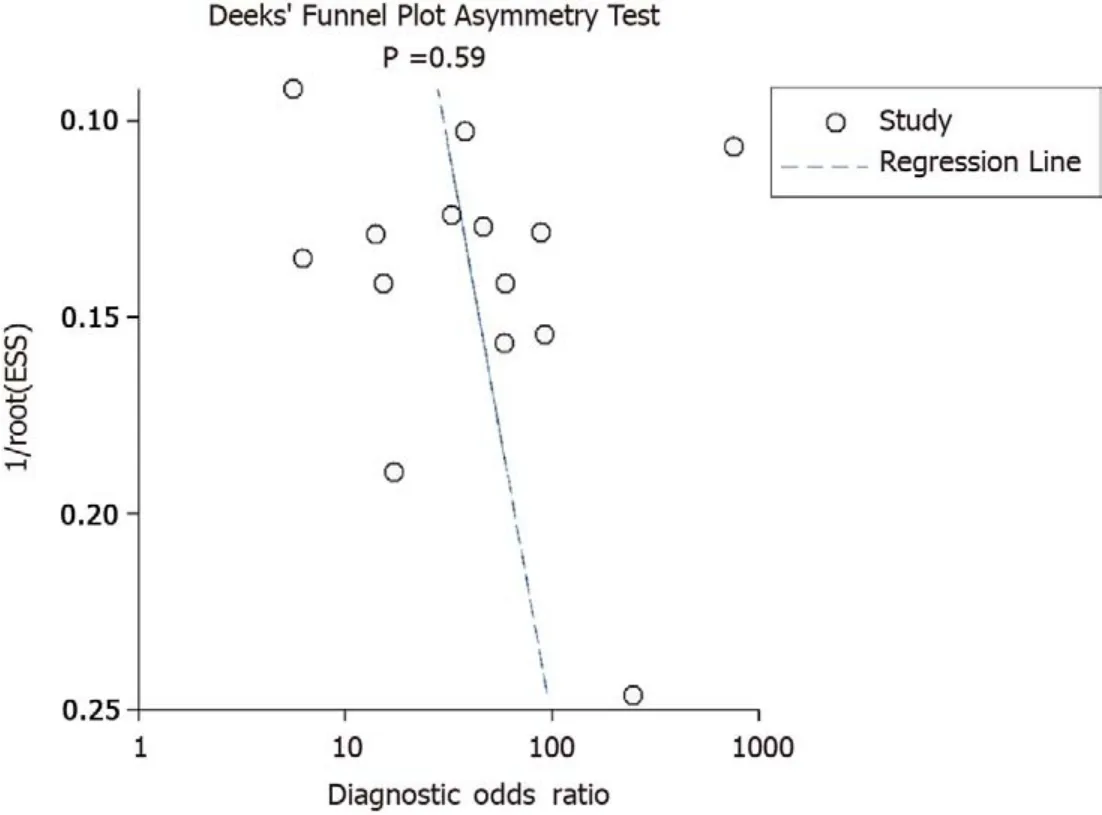
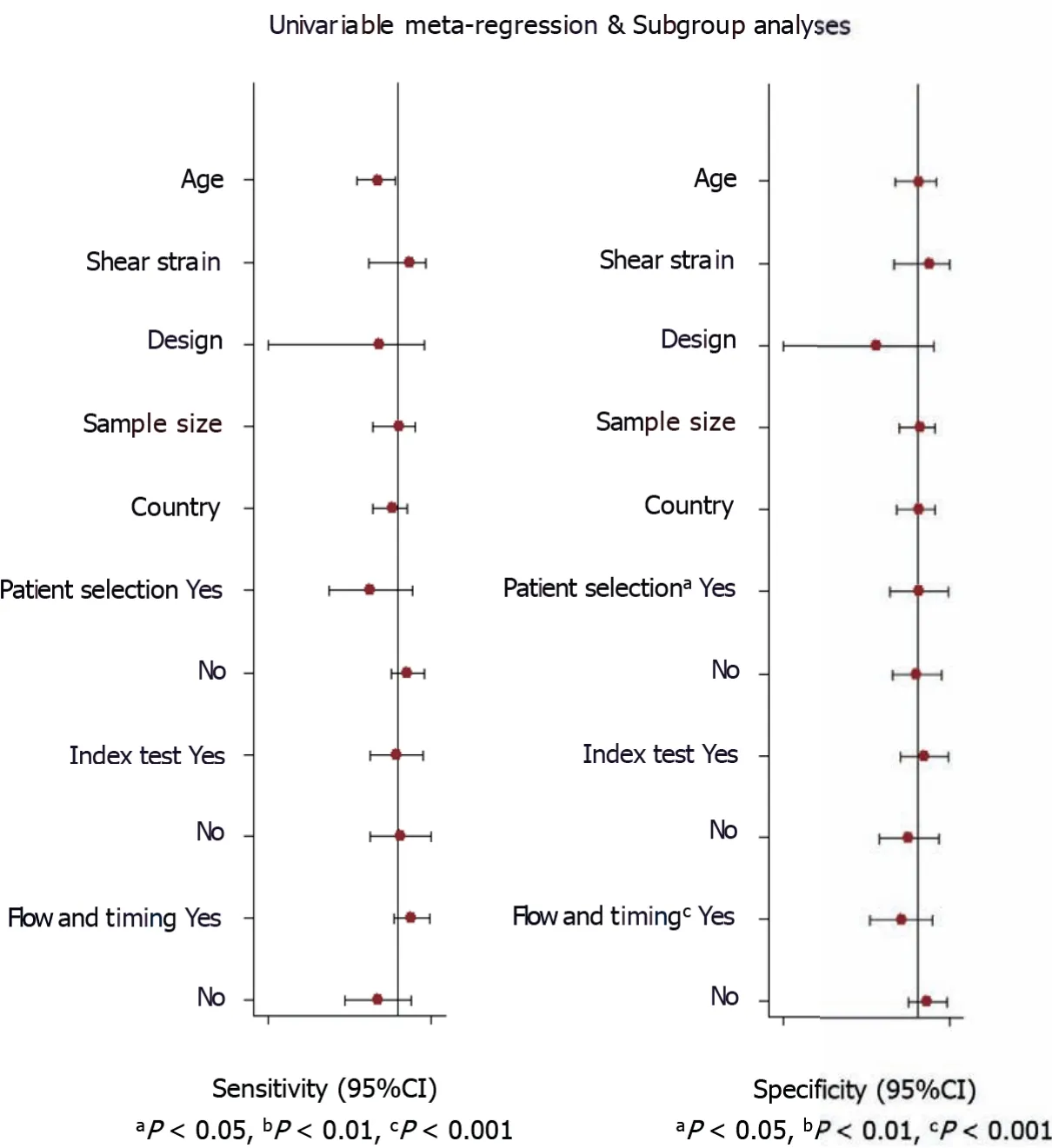
We next performed a subgroup analysis based on the type of elastography used for predicting pCR after NACT. Eight studies used shear-wave elastography for assessing its prognostic utility. Our results show a pooled sensitivity of 77% and pooled specificity of 84% with a DOR of 17, LRP of 4.8, and LRN of 0.27. Seven studies used strain-wave elastography for assessing its prognostic utility. Our results indicate a pooled sensitivity of 93% and pooled specificity of 87% with a DOR of 87, LRP of 7.4, and LRN of 0.08.
Two independent investigators (LF and HC) rated the included studies based on the level of bias risk using the quality assessment of diagnostic accuracy studies-2 (QUADAS-2) tool. The studies were rated for the following domains:Patient selection, conduct & interpretation of the index and reference tests,and flow and timing of outcome assessment[6]. Discrepancies and disagreements during the rating of studies were resolved by the third investigator who helped in achieving the consensus and rated all the studies as unclear, low, or high quality (based on the risk of bias).
DlSCUSSlON
Major objectives of performing the NACT are to attain operability, and ensure breast conservation and historical prognostic information. In recent years, the approach shifted towards personalization of the therapy, investigation of new therapies, and identification of response biomarkers. More advanced and accurate prediction of pCR will allow to identify high-risk groups and prevent adverse outcomes by providing more specific management. Developing a fast, easy, and effective screening tool will reduce the financial burden on healthcare system, prevent life-threatening complications, and reduce mortality.However, the utility of UE has not been synthesized to predict the risk of pCR. The main goal of this review was to determine the predictive performance of shear and strain wave ultrasound elastography for the pCR.
Of course not, said the old man. But, if it did, you need not worry. She would never divorce you. Oh, no! And, of course, she will never give you the least, the very least, grounds for-uneasiness.
A total of 14 studies reporting the utility of UE for predicting pCR following NACT were identified by our systematic search strategy. Most of the studies were prospective and had a low risk of bias. UE had an equal pooled sensitivity and specificity of 86%. Other diagnostic accuracy parameters also were moderate. LR scattergram showed that, since LRN and LRP occupied the right lower quadrant, UE cannot be used for confirming or excluding SAP. The clinical utility of UE was relatively acceptable,with a significant rise in the post-imaging probability compared to the pre-imaging probability on Fagan’s nomogram.
Meta-analysis was performed using the STATA version 14 software (StataCorp, TX, United States).Sensitivity and specificity were pooled by bivariate method for predicting the pCR following NACT in breast cancer patients using UE. We also estimated other important accuracy parameters such as positive and negative likelihood ratios (LRP and LRN, respectively) and diagnostic odds ratio (DOR) for the predictive utility of UE. We also reported these results separately for shear wave and strain wave elastography. We have reported these results using the following plots:Forest plot to depict pooled specificity and sensitivity, LR scattergram to depict the LRP and LRN, and Fagan plot to depict the preand post-test probabilities. LR scattergram consists of the following four quadrants with its interpretation:Left upper quadrant (LRP value > 10, LRN value < 0.1) indicative of confirmation &exclusion diagnostic criterion, right upper quadrant (LRP value > 10, LRN value > 0.1) indicative of confirmation diagnostic criterion, left lower quadrant (LRP value < 10, LRN value < 0.1) indicative of exclusion diagnostic criterion, and right lower quadrant (LRP value < 10, LRN value > 0.1) indicative of neither confirmation nor exclusion diagnostic criterion. “”(sROC) was used to report the summary predictive accuracy of UE for pCR.
Well, to tell you the truth, the peach I ate would be considered a bad peach, so of course stores don t like to sell them. I was sold that one by mistake, most likely. And so now Gaston is without a home, and we ve got six perfect peaches to eat.
The accuracy parameters obtained in this review could not be compared, since no similar reviews were conducted in the past. Nevertheless, our results are almost similar to the accuracy of UE in predicting malignant liver lesions or axillary lesions[21,22]. There is a need for additional studies comparing the prognostic performance of this imaging technique with magnetic resonance imaging and other forms of ultrasonography, in order to identify the method with the highest accuracy that can be used in the clinical practice. Further large-scale longitudinal studies are also needed to assess the predictive accuracy of strain wave elastography as only few studies reported this outcome.
This very afternoon the princess had left all her women asleep, and, after trying in vain to amuse herself indoors, she had slipped out into the great garden, and rambled60 about in all her favourite nooks and corners, feeling quite safe as there was not a creature to be seen
We found that UE had an equal pooled sensitivity and specificity of 86% for predicting the pathologic complete response (pCR) in breast cancer patients following NACT. We also found that strain wave elastography was the better technique with a pooled sensitivity of 93% and specificity of 87% compared to shear wave elastography (77% and 84%). This means that strain elastography can help in effectively ruling out the patients correctly as it had a sensitivity more than 90%.
When the jar was filled, Dad would sit at the kitchen table and roll the coins before taking them to the bank. Taking the coins to the bank was always a big production. Stacked neatly5 in a small cardboard box, the coins were placed between Dad and me on the seat of his old truck. Each and every time, as we drove to the bank, Dad would look at me hopefully. Those coins are going to keep you out of the textile mill, son. You re going to do better than me. This old mill town s not going to hold you back. Also, each and every time, as he slid the box of rolled coins across the counter at the bank toward the cashier, he would grin proudly. These are for my son s college fund. He ll never work at the mill all his life like me.
It is important to interpret these results with caution, as there are several differences in the methods and quality of our included studies, which can ultimately affect the final pooled estimates. First, we evaluated and found a significant heterogeneity (significant chi-square test and higherstatistic values). Hence, we performed meta-regression and found the factors responsible for this higher heterogeneity. Quality related factors and mean age were found to be the significant covariates responsible for such heterogeneity. We confirmed that there was no publication bias in the studies reporting our study outcome using Deek’s test and funnel plot.
I must make one effort to go, said Anne Lisbeth, to see mydarling, the count s sweet child, and press him to my heart. Certainlyhe must long to see me, too, the young count; no doubt he thinks of me and loves me, as in those days when he would fling his angel-armsround my neck, and lisp Anne Liz. It was music to my ears. Yes, Imust make an effort to see him again. She drove across the country in a grazier s cart, and then got out, and continued her journey on foot, and thus reached the count s castle. It was as great and magnificent as it had always been, and the garden looked the same as ever; all the servants were strangers to her, not one of them knew Anne Lisbeth, nor of what consequence she had once been there; but she felt sure the countess would soon let them know it, and her darling boy, too: how she longed to see him!
Our study has certain strengths. This is the first meta-analysis assessing the predictive ability of UE for pCR amongst breast cancer patients, with a larger number of studies (14 studies) included. Lack of significant publication bias adds credibility of the results in the meta-analysis. However, there are several limitations to our study. First, there was a significant between-study variability in our analysis.This can limit the prospect to infer or interpret the pooled findings. However, we explored the source of
heterogeneity using meta-regression analysis to overcome this limitation. Second, the predictive accuracy of UE depends on several other factors such as the ethnicity, timing of the index test and outcome assessment, and disease severity. However, we could not evaluate their influence in our analysis. We have also not pre-registered this review online. Finally, the number of subjects/participants included was relatively small.
CONCLUSlON
Despite these limitations, our study findings provide useful information for the clinicians and oncologists and may have significant implications for developing treatment strategies for breast cancer patients following NACT. Although UE had moderate sensitivity and specificity, strain-wave type of UE had a very high accuracy to rule out the patients with pCR. It should be useful, therefore, as an effective prognostic tool following the administration of NACT, because it may allow for identification of the patients at risk of developing incomplete pathological response. Applying this imaging technique could reduce the time spent undertaking various invasive diagnostic procedures and could also reduce the healthcare costs involved in the process. However, ultrasonography-based imaging techniques have substantial overlap between benign and malignant features, mainly for small lesions. A palpation imaging technique could help compensate for this deficiency by comprehensively analyzing the 2-D and 3-D tumor characteristics[23]. At the same time, it may be difficult to diagnose intraductal lesions and calcification in breast masses using palpation imaging. This, in turn, can be overcomeultrasound or mammography. Hence, future studies perhaps should attempt to combine palpation imaging,ultrasonography, and mammography to analyze ambiguous clinical cases in order to improve breast lesion diagnosis. Additional large-scale setting-specific longitudinal studies are merited to establish the best imaging methods to assess all the patients administered with NACT.
ARTlCLE HlGHLlGHTS
Research background
Several studies have reported the prognostic value of ultrasound elastography (UE) in patients receiving neoadjuvant chemotherapy (NACT) for breast cancer. However, the assessment of parameters is different for shear-wave elastography and strain elastography in terms of measured elasticity parameter and mode of imaging.
Research motivation
To the best of our knowledge, no meta-analysis has been conducted to assess the accuracy of the two modes of elastography in predicting the response to NACT.
Research objectives
The aim of the current study was to systematically search the literature for all studies assessing the accuracy of UE for predicting response to NACT in breast cancer, and pool the data for meta-analysis.
Research methods
A comprehensive and systematic search was performed in the databases of MEDLINE, EMBASE,SCOPUS, PubMed Central, CINAHL, Web of Science, and Cochrane library from inception until December 2020.
Then they applied21 for advice to one of the wise men of the world,and he sent them a message to say that there was one remedy whichwould relieve and cure him, and that it was a plant of heavenly originwhich grew in the forest in the king s own dominions22. The messengerdescribed the flower so that is appearance could not be mistaken.Then said the swineherd, I am afraid I carried this plant awayfrom the forest in my bundle, and it has been burnt to ashes long ago.But I did not know any better.
Research results
55. White duck: According to Diann Rusch-Feja, the duck represents a maternal127 replacement128 since it represents a feminine aspect in Germanic tradition along with swans and geese (Rusch-Feja 1995). The duck rescues the children when their own mother figures fail them.
Research conclusions
Strain-wave type of UE can accurately predict the pCR following NACT amongst breast cancer patients.
Research perspectives
Additional large-scale setting-specific longitudinal studies are merited to establish the best imaging methods to assess all the patients administered with NACT.
Chen W and Zheng JH conceived and designed the study; Fang LX, Chen HL, and Zheng JH were involved in literature search and data collection; Chen W analyzed the data and wrote the paper; Zheng JH reviewed and edited the manuscript; all authors read and approved the final manuscript.
The authors deny any conflict of interest.
The authors have read the PRISMA 2009 checklist and the manuscript was prepared and revised according to the PRISMA 2009 checklist.
This article is an open-access article that was selected by an in-house editor and fully peer-reviewed by external reviewers. It is distributed in accordance with the Creative Commons Attribution NonCommercial (CC BYNC 4.0) license, which permits others to distribute, remix, adapt, build upon this work non-commercially, and license their derivative works on different terms, provided the original work is properly cited and the use is noncommercial. See:https://creativecommons.org/Licenses/by-nc/4.0/
Then the little hare went the round of the village, saying to every hyaena he met, Go and get into the boiling water, so that in a little while there was hardly a male left in the village
China
Wei Chen 0000-0003-1693-6797; Li-Xiang Fang 0000-0003-1759-9577; Hai-Lan Chen 0000-0001-8531-484X; Jian-Hua Zheng 0000-0002-8336-1113.
Fan JR
Wang TQ
Wu RR
 World Journal of Clinical Cases2022年11期
World Journal of Clinical Cases2022年11期
- World Journal of Clinical Cases的其它文章
- Pleomorphic adenoma of the left lacrimal gland recurred and transformed into myoepithelial carcinoma after multiple operations:A case report
- Thyrotoxicosis after a massive levothyroxine ingestion:A case report
- Contrast-enhanced ultrasound manifestations of synchronous combined hepatocellular-cholangiocarcinoma and hepatocellular carcinoma:A case report
- Papillary thyroid microcarcinoma with contralateral lymphatic skip metastasis and breast cancer:A case report
- Del(5q) and inv(3) in myelodysplastic syndrome:A rare case report
- Ultrasound-guided local ethanol injection for fertility-preserving cervical pregnancy accompanied by fetal heartbeat:Two case reports
